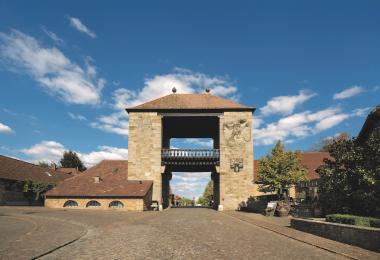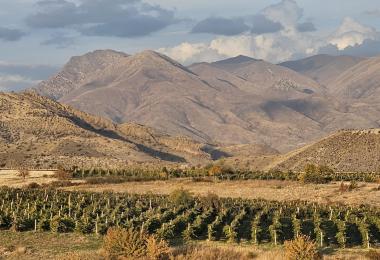Robust, spicy Blaufränkisch and Zweigelt from Burgenland, racy-herbal Schilcher from Weststeiermark or crisp-fruity Zweigelt and Sankt Laurent from the diverse terroirs of Niederösterreich – Austria’s treasure chest holds rosé jewels in dry, off-dry, sweet and sparkling styles. In some regions, the tradition runs so deep, that their pink-hued specialties have become DAC protected designations of origin.
The demarcated region for Rosalia DAC Rosé hugs the Hungarian border west of Lake Neusiedl, between the Leithaberg DAC and the Mittelburgenland DAC. The predominant grape varieties are Blaufränkisch and Zweigelt, which benefit from the warm Pannonian climate and sandy loam soils of the Rosalia Hills. The resulting rosés beguile with juicy red-berried fruit and peppery spice.

Rosé from the Rosalia region enchants with juicy red-berried fruit and peppery spice
Credit: ÖWM - Marcus-Wiesner
Blauer Wildbacher is found nearly nowhere else in the world but makes up two thirds of the vineyard area in Weststeiermark. Schilcher is the old regional name for the shimmering salmon or onion skin coloured rosé specialty made from this rare grape variety. The Weststeiermark DAC Schilcher designation of origin is a romantic, undulating landscape with gneiss and mica-schist soils. Its dry, rosé wines exude strawberry, red currant and herbal-cassis aromas that are highlighted by racy acidity. Sparkling Schilcher specialties exhibit the versatility of the ancient Blauer Wildbacher variety and reward wine lovers with unique and delicious enjoyment.

Weststeiermark is famous for Schilcher, a rosé specialty made from the very rare Blauer Wildbacher grape
Credit: ÖWM - Armin Faber
Austria has a 175-year tradition for sparkling wine production. Unlike other sparkling wine origins of the world, including Champagne, the Austrian Sekt g.U. protected designation of origin forbids the blending of red and white wines for its rosé specialties. Sparkling rosé with the Austrian Sekt g.U. designation must be made from rosé base wines. Only classified red wine varieties are permitted. The most common grapes varieties are Pinot Noir, Blaufränkisch, Zweigelt, St. Laurent and Blauer Wildbacher (Schilcher). As you move up through the category hierarchy of Austrian Sekt g.U. from Klassik to Reserve to Grosse Reserve, these classy sparkling wines spend increasingly more time on the lees and come from smaller, more precisely defined origins.

Powerful, spicy versions of Austrian rosé pair wonderfully with Indian dishes like Lamb Biryani
Credit: ÖWM - Blickwerk-Fotografie
A plethora of autochthonous and international grape varieties combine with Austria’s terroir diversity to offer many interesting rosé wines that are wonderful companions to creative cuisine. There are virtually no limits when it comes to combinations: from roasted poultry, grilled fish and seafood to spicy salads and braised Mediterranean vegetables – even with olives and garlic. Light or sparkling Austrian rosé pairs wonderfully with beef carpaccio or fried spring rolls. Fruity and spicy versions are delicious with roast chicken, spaghetti vongole or Indian paneer tikka. Powerful, racy interpretations adore roast pork, Indian lamb biryani or charcuterie. The rare, sweet rosé wines are stellar with strawberries and cream or other fruity desserts. Guten Appetit!








